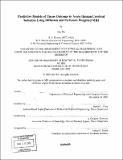| dc.contributor.advisor | Martha L. Gray and A. Gregory Sorensen. | en_US |
| dc.contributor.author | Wu, Ona | en_US |
| dc.contributor.other | Massachusetts Institute of Technology. Dept. of Electrical Engineering and Computer Science. | en_US |
| dc.date.accessioned | 2005-08-23T19:27:21Z | |
| dc.date.available | 2005-08-23T19:27:21Z | |
| dc.date.copyright | 2002 | en_US |
| dc.date.issued | 2002 | en_US |
| dc.identifier.uri | http://hdl.handle.net/1721.1/8358 | |
| dc.description | Thesis (Ph. D.)--Massachusetts Institute of Technology, Dept. of Electrical Engineering and Computer Science, 2002. | en_US |
| dc.description | Includes bibliographical references. | en_US |
| dc.description.abstract | Diffusion (DWI) and perfusion weighted (PWI) magnetic resonance imaging (MRI) provide significant insight into acute stroke and can potentially be useful for clinical decision-making. In particular, current therapeutic decisions for acute human cerebral ischemia are typically based on time of symptom onset, limiting the number of patients treated. Imaging, however, offers insight into the physiologic integrity of brain tissue that is not attainable with time of symptom onset alone. This thesis extends existing imaging techniques for acute human stroke in order to improve identification of tissue at risk of infarction, thereby assisting clinical decision-making at the stage when intervention may be most effective. DWI and PWI have both been shown to identify infarcted tissue earlier than conventional stroke imaging. However, these techniques are limited in their existing implementations. DWI in most acute stroke settings has been restricted to isotropic imaging, measuring only mean diffusivity. In this thesis, DWI is extended to diffusion tensor imaging (DTI) with results demonstrating that DTI can detect ultrastructural changes in acute human stroke. PWI measures perfusion status by tracking the first pass of a bolus of contrast agent. In this dissertation, using numerical simulations, delay in contrast agent arrival is found to result in biased estimates of perfusion indices. A deconvolution technique using a block-circulant matrix is therefore proposed to compensate for delayed arrival, and its performance is compared to non-block circulant techniques in simulations as well as in clinically acquired human data sets. | en_US |
| dc.description.abstract | (cont.) The results show that decoupling delay-associated effects reduces bias in tissue perfusion estimates. Algorithms combining DWI and PWI information are also evaluated to determine whether they predict tissue outcome in acute stroke better than models using only subsets of these parameters. Results show that algorithms combining DWI and PWI on a voxel-by-voxel basis predict tissue that infarct with higher specificity and sensitivity than algorithms using DWI or PWI individually. These combination algorithms are then used to investigate the efficacy of a novel therapeutic agent by evaluating the performance of the model as a function of treatment dose. Findings suggest that predictive models allow evaluation of novel therapies using smaller sample sizes than traditional endpoints. The results of this dissertation demonstrate that imaging can be used to identify tissue at risk of infarction, which may aid diagnosis and prognosis by providing clinicians unique insight into the underlying pathophysiology of stroke. | en_US |
| dc.description.statementofresponsibility | by Ona Wu. | en_US |
| dc.format.extent | 156 p. | en_US |
| dc.format.extent | 19858650 bytes | |
| dc.format.extent | 19858407 bytes | |
| dc.format.mimetype | application/pdf | |
| dc.format.mimetype | application/pdf | |
| dc.language.iso | eng | en_US |
| dc.publisher | Massachusetts Institute of Technology | en_US |
| dc.rights | M.I.T. theses are protected by copyright. They may be viewed from this source for any purpose, but reproduction or distribution in any format is prohibited without written permission. See provided URL for inquiries about permission. | en_US |
| dc.rights.uri | http://dspace.mit.edu/handle/1721.1/7582 | |
| dc.subject | Electrical Engineering and Computer Science. | en_US |
| dc.title | Predictive models of tissue outcome in acute human cerebral ischemia using diffusion and perfusion weighted MRI | en_US |
| dc.type | Thesis | en_US |
| dc.description.degree | Ph.D. | en_US |
| dc.contributor.department | Massachusetts Institute of Technology. Department of Electrical Engineering and Computer Science | |
| dc.identifier.oclc | 50547830 | en_US |
